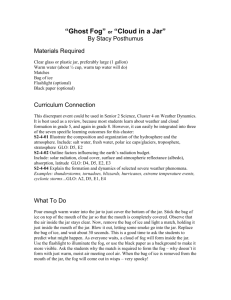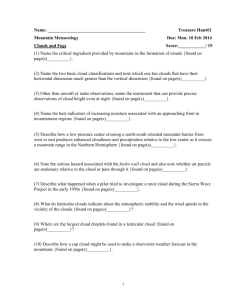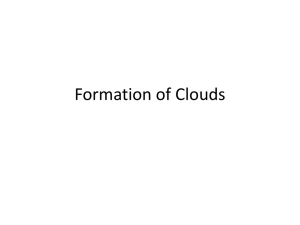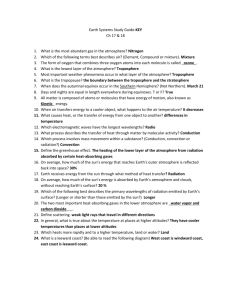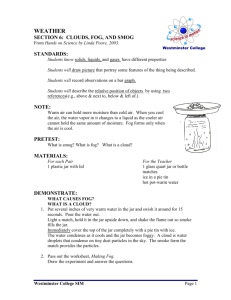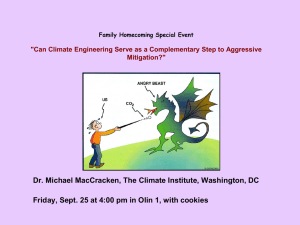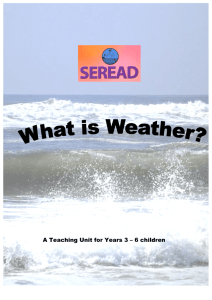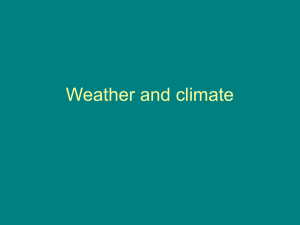Nature of Science capabilities linking template
advertisement
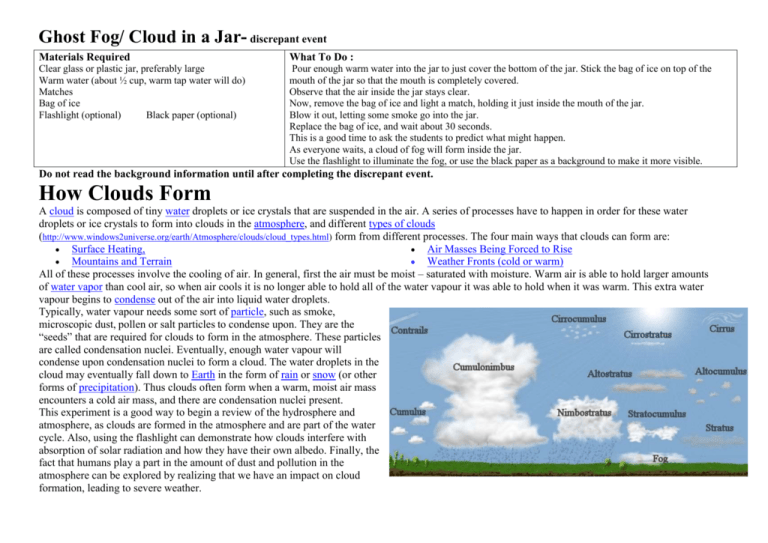
Ghost Fog/ Cloud in a Jar- discrepant event Materials Required What To Do : Clear glass or plastic jar, preferably large Warm water (about ½ cup, warm tap water will do) Matches Bag of ice Flashlight (optional) Black paper (optional) Pour enough warm water into the jar to just cover the bottom of the jar. Stick the bag of ice on top of the mouth of the jar so that the mouth is completely covered. Observe that the air inside the jar stays clear. Now, remove the bag of ice and light a match, holding it just inside the mouth of the jar. Blow it out, letting some smoke go into the jar. Replace the bag of ice, and wait about 30 seconds. This is a good time to ask the students to predict what might happen. As everyone waits, a cloud of fog will form inside the jar. Use the flashlight to illuminate the fog, or use the black paper as a background to make it more visible. Do not read the background information until after completing the discrepant event. How Clouds Form A cloud is composed of tiny water droplets or ice crystals that are suspended in the air. A series of processes have to happen in order for these water droplets or ice crystals to form into clouds in the atmosphere, and different types of clouds (http://www.windows2universe.org/earth/Atmosphere/clouds/cloud_types.html) form from different processes. The four main ways that clouds can form are: Surface Heating, Air Masses Being Forced to Rise Mountains and Terrain Weather Fronts (cold or warm) All of these processes involve the cooling of air. In general, first the air must be moist – saturated with moisture. Warm air is able to hold larger amounts of water vapor than cool air, so when air cools it is no longer able to hold all of the water vapour it was able to hold when it was warm. This extra water vapour begins to condense out of the air into liquid water droplets. Typically, water vapour needs some sort of particle, such as smoke, microscopic dust, pollen or salt particles to condense upon. They are the “seeds” that are required for clouds to form in the atmosphere. These particles are called condensation nuclei. Eventually, enough water vapour will condense upon condensation nuclei to form a cloud. The water droplets in the cloud may eventually fall down to Earth in the form of rain or snow (or other forms of precipitation). Thus clouds often form when a warm, moist air mass encounters a cold air mass, and there are condensation nuclei present. This experiment is a good way to begin a review of the hydrosphere and atmosphere, as clouds are formed in the atmosphere and are part of the water cycle. Also, using the flashlight can demonstrate how clouds interfere with absorption of solar radiation and how they have their own albedo. Finally, the fact that humans play a part in the amount of dust and pollution in the atmosphere can be explored by realizing that we have an impact on cloud formation, leading to severe weather. Nature of SCIENCE FOCUS bites 2014 Understanding about Science Learn about science as a knowledge system: the features of scientific knowledge and the processes by which it is developed; and learn about the ways in which the work of scientists interacts with society. Achievement Objectives level 1 & 2 Using evidence Science is a way of explaining the world. Science is empirical and measurable. This means that in science, explanations need to be supported by evidence that is based on, or derived from, observations of the natural world At the very core of science is theory building – making better explanations. What sets scientific explanations apart from other ways of explaining the world is their reliance on evidence and their ability to evolve as new evidence comes to light Scientifically literate citizens understand the importance of a sceptical disposition towards all empirical evidence and the role of argument (in science) and critique in the construction of knowledge in science. Achievement Objectives level 3 & 4 New language… • Appreciate that scientists ask questions about our world that lead to investigations and that openmindedness is important because there may be more than one explanation. • Appreciate that science is a way of explaining the world and that science knowledge changes over time. • Identify ways in which scientists work together and provide evidence to support their ideas How do you know that? ; there is water vapour inside the glass? What makes you think so? Making careful observations to use as evidence, what do you see in the jar at first? What changes? Does the evidence change your ideas/ thinking? ; about what clouds are and how they are formed? About how human activities could affect the clouds and the weather. ; Investigating in Science Communicating in Science Participating and contributing Develop knowledge of the vocabulary, numeric and symbol systems, and conventions of science and use this knowledge to communicate about their own and others’ ideas Bring a scientific perspective to decisions and actions as appropriate. • Extend their experiences and personal explanations of the natural world through exploration, play, asking questions, and discussing simple models. • Build their language and develop their understandings of the many ways the natural world can be represented. • Explore and act on issues and questions that link their science learning to their daily living. • Build on prior experiences, working together to share and examine their own and others’ knowledge. • Ask questions, find evidence, explore simple models, and carry out appropriate investigations to develop simple explanations. How could you check that? There is water vapour in the fog? That there is water vapour in the air? So an example of this would be... Can you think of an example when this wouldn’t work? Gathering evidence to test their science idea, what does it look like? Smell like? Feel like? Developing explanations based on evidence Using evidence to support their ideas. Why doesn’t fog form with just warm, moist air meeting cool air? Is there enough evidence to support your ideas? Why does the fog come out in wisps when the bag of ice is removed from the mouth of the jar? • Begin to use a range of scientific symbols, conventions, and vocabulary. • Engage with a range of science texts and begin to question the purposes for which these texts are constructed. Sharing explanations of experiences and observations from the evidence • Use their growing science knowledge when considering issues of concern to them • Explore various aspects of an issue and make decisions about possible actions Carry out science investigations using a variety of approaches: classifying and identifying, pattern seeking, exploring, investigating models, fair testing, making things, or developing systems My observations / visual/ written… Give opportunities for practicing evidence-based talk: e.g. I think… because… What if we used something other than smoke? What could we use? Make a summary of what you noticed Use a table to record evidence to draw on your own investigation. Making decisions based on evidence- How will this knowledge help you in your daily life? how the weather would change without human influence? Justify an opinion based on their scientific knowledge using evidence Do you need to consider multiple pieces of evidence before making a judgment? Why the match is required to form the fog?
